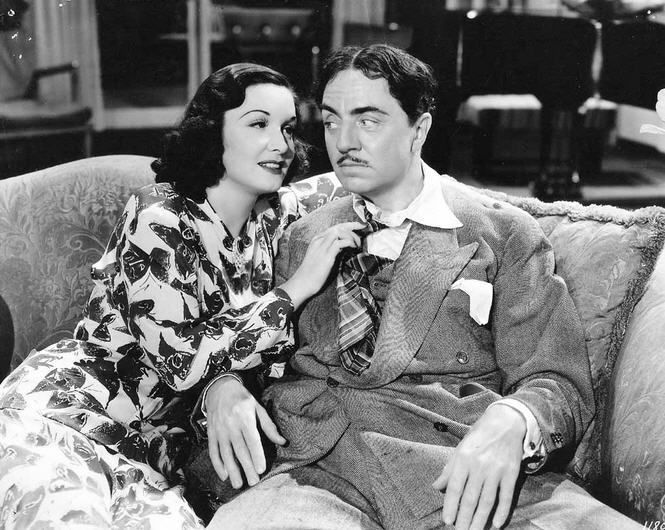Love Crazy (1941)
- Soames Inscker

- Jul 8, 2025
- 4 min read

Love Crazy (1941) is a sparkling example of screwball comedy, and a delightful testament to the enduring screen chemistry between William Powell and Myrna Loy.
Best known for their iconic roles as Nick and Nora Charles in The Thin Man series, Powell and Loy teamed up for Love Crazy during a time when audiences needed levity more than ever—amidst the mounting tensions of World War II. Directed by Jack Conway and produced by the ever-reliable MGM, the film combines mistaken identities, slapstick, fast-paced repartee, and a dose of romantic lunacy to produce an effervescent farce that still holds its comedic charm.
Plot Summary
Steve Ireland (William Powell) and his wife Susan (Myrna Loy) are preparing to celebrate their fourth wedding anniversary. Things go hilariously awry when Steve runs into his old flame, Isobel (Gail Patrick), who manipulates her way back into his life with the intent of reigniting their past romance. In a classic screwball twist, Susan walks in on a perfectly innocent but compromising situation, assumes the worst, and begins divorce proceedings.
Steve, unwilling to lose Susan, hatches a desperate and outrageous plan: he feigns insanity to delay the divorce long enough to win her back. What ensues is a madcap rollercoaster involving psychiatric evaluations, cross-dressing, mistaken identities, elevator chases, slapstick fistfights, and institutionalisation. Each scene builds upon the next with escalating absurdity, culminating in a hilarious cross dressing finale.
Performances

William Powell shines as the beleaguered but cunning Steve. His mastery of deadpan delivery and physical comedy is on full display. Whether he’s pretending to be insane or donning a woman’s disguise to avoid capture, Powell demonstrates perfect timing and a natural flair for comic nuance. His dignity remains intact even while committing the most ludicrous acts—a signature of his comedic style.
Myrna Loy brings wit, warmth, and strength to Susan. She is more than just a straight-woman to Powell’s antics; she matches him beat for beat in their verbal sparring, and her reactions to Steve's madness are both sympathetic and hilariously exasperated. Loy's portrayal of a woman scorned yet still loving adds a rich emotional layer beneath the farce.
Gail Patrick excels in her typical role as the elegant and manipulative “other woman.” As Isobel, she plays the foil to Loy’s Susan with just enough bite to provoke chaos, but never tips into villainy. Jack Carson as Ward Willoughby, the blustering neighbour and romantic rival, offers a strong supporting turn that enhances the comedic tension.
Direction and Writing
Director Jack Conway, a dependable MGM workhorse, keeps the pace brisk and the tone buoyant. While Love Crazy lacks the visual innovation of contemporaneous screwball films like Bringing Up Baby (1938), Conway’s straightforward style allows the actors’ chemistry and the witty script to take centre stage.
The screenplay, penned by David Hertz and adapted from a story by Krafft and Vina Delmar, delivers rapid-fire dialogue and inventive set-ups. The writing smartly balances absurdity with heart, ensuring the characters never become mere caricatures despite the zaniness of the plot.
Themes and Tone

At its core, Love Crazy is a satire of marriage, jealousy, and gender expectations. The film plays with the notion of sanity—literal and metaphorical—as it relates to love. Steve’s deliberate descent into "madness" is both a comic device and a metaphor for the irrational extremes people are willing to endure for love. The film also explores the social rigidity of divorce and propriety, making light of the convoluted steps couples had to go through to separate or reunite.
The tone is broadly comic but never mean-spirited. There’s a warmth underlying the madness, especially in the affectionate banter between Powell and Loy, which ensures that the film remains grounded even as it indulges in outrageous comedic setups.
Cinematography and Production Design
The cinematography by Ray June is competent, if not particularly stylized. The sets—luxurious Manhattan apartments, elevators, courtrooms, and a sanitarium—are typical of MGM's polished studio production, evoking a heightened reality perfect for farce. The costuming is also a highlight, particularly in the scenes where Powell disguises himself as a woman, leading to some wonderfully ludicrous visuals.
Legacy and Reception
Love Crazy was a box office success upon release, further cementing the Powell-Loy partnership as one of Hollywood’s most bankable pairings. Though not as critically acclaimed or culturally influential as The Thin Man, Love Crazy is beloved by fans of classic Hollywood comedy for its zany premise, witty dialogue, and star-powered charm.
Over time, it has become a favourite among classic film enthusiasts, especially those who appreciate screwball comedy’s unique blend of intelligence and absurdity. Modern audiences may find some of the gender roles or social attitudes dated, but the core romantic hijinks and comic timing remain highly effective.
Conclusion
Love Crazy (1941) is a delightful screwball gem that thrives on the impeccable chemistry of William Powell and Myrna Loy. It’s a testament to the durability of their onscreen partnership and to the timeless appeal of romantic comedy done right. With its smart writing, exuberant performances, and sheer comic audacity, the film remains a highlight of early 1940s cinema and a must-see for fans of classic Hollywood.
Rating
A high-spirited farce full of warmth, wit, and wild reversals. Powell and Loy never miss a beat—and neither will your smile.






